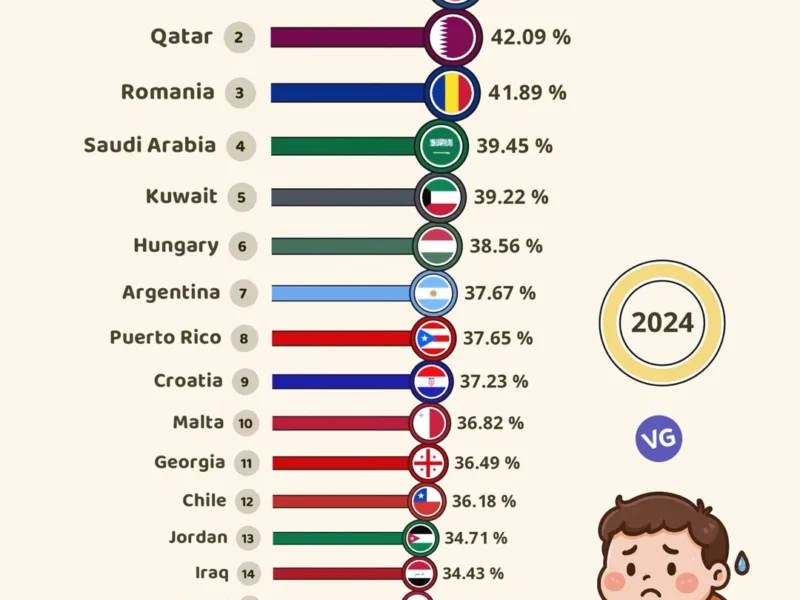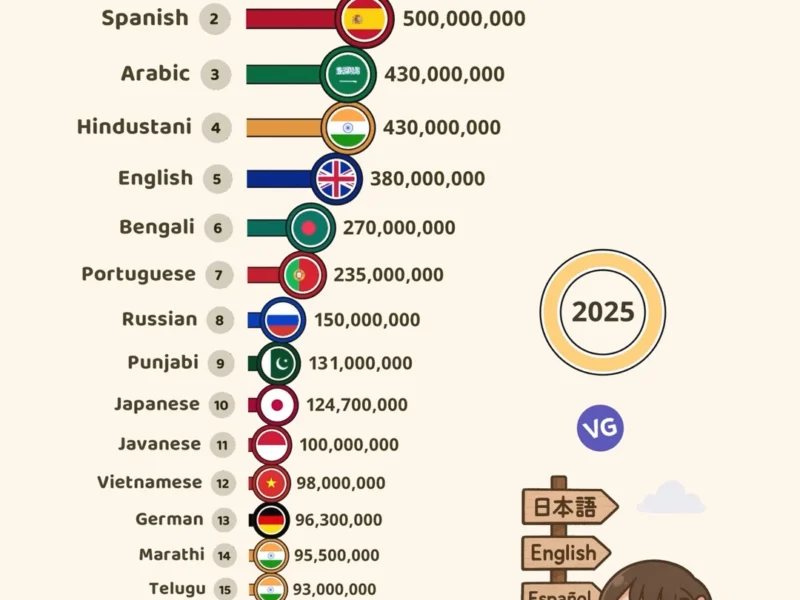India ranks third globally in terms of Muslim population, with about 14.2% of its people being Muslim. This data is from the 2011 census.1 Since the country was divided, India’s population has tripled. It went from 361 million in 1951 to over 1.2 billion by 2011.1 About 1 million people are added to India’s population every month. This growth may lead India to become the world’s most populous country by 2030, as per the United Nations Population Division.
Key Takeaways
- India has the third-largest Muslim population in the world, comprising around 14.2% of the total population.
- India’s population has more than tripled since 1951, with the country poised to surpass China as the world’s most populous by 2030.
- The Muslim population in India expanded by 32.7% between 1951 and 1961, and by 24.7% from 2001 to 2011.
- The share of the Muslim population in India increased by 43.15% between 1950 and 2015, rising from 9.84% to 14.09%.
- India’s Muslim population was approximately 172.2 million in the 2011 census, with significant regional variations.
Introduction to Islam in India
Since ancient times, the Indian subcontinent and Arabia have shared trade links.2 Arabs journeyed to places like the Konkan-Gujarat and Malabar coasts, connecting them to Southeast Asian ports. Examining the history of Islam’s arrival in india, Elliot and Dowson noted that the first Muslim ship was spotted around 630 CE.2 Rawlinson, in his work, stated that Arab Muslims started settling on the Indian coast in the late 7th century CE.2 Islam spread through Gujarat and the Malabar Coast along trade routes within Indian communities shortly after emerging in the Arabian Peninsula.
Historical Roots of Islam in the Subcontinent
In the 7th century, Arabs conquered Sindh, bringing Islam inward to the Indian subcontinent. This faith later spread to Punjab and North India by the 12th century through the Ghaznavids and Ghurids, becoming a key part of india’s culture and spirituality.2
Spread of Islam along Trade Routes
India’s early mosques, like the Barwada Mosque in Gujarat and the Cheraman Juma Mosque in Kerala, were built in the 7th century.2 Studies on Indian Muslim genetics show little outside gene flow, mainly from the Middle East and Central Asia. Yet, Indian Muslim communities maintain their traditions and marry within their own groups.2 A study looking at the Y chromosomes of Indian Muslims revealed that Shias in Uttar Pradesh shared an E haplogroup, suggesting a slight tie to Iraqis, Turks, and Palestinians.2
Muslim Demographics in Modern India
In 2011, Southern India, especially Kerala and Tamil Nadu, had lots of Christians. The Northeastern states near China, Bhutan, Myanmar, and Bangladesh also had many Christians.1 Majority of Muslims live in Jammu and Kashmir, next to Pakistan. There, Muslims make up most of the people, besides a few islands in Lakshadweep.2
India’s Muslim Population by Numbers
Uttar Pradesh stands first with over 38 million Muslims. Then comes West Bengal with about 25 million, and Bihar with 18 million. Maharashtra follows with 13 million Muslims.2 In total, Muslims are about 14.2% of India’s population based on 2011 census figures.12
Regional Distribution of Indian Muslims
Some Indian states have more Muslims than others. For example, Uttar Pradesh has a whopping 38,483,970. West Bengal and Bihar boast 24,654,830 and 17,557,810 respectively.2 Maharashtra and Assam have over 10 million each, while Kerala has almost 9 million.2 In Jammu and Kashmir, there are around 8.6 million Muslims. Andhra Pradesh has 8 million plus, including Telangana.2 Additionally, Karnataka features 7.8 million Muslims, and Rajasthan claims 6.2 million.2
muslim population in india
In 2011, a census found India as the third country with the most Muslims in the world. They make up about 14.2% of India’s overall people. The total Muslim population was estimated at 172.2 million then.1
Since the country’s Partition, the spread of different religions across states has mostly stayed the same. The states with the most Muslims are Uttar Pradesh, West Bengal, Bihar, and Maharashtra.
| Key Statistics on Muslim Population in India | Values |
|---|---|
| Share of Muslim population in India’s total population in 2015 | 14.09%3 |
| Increase in Muslim population share between 1950-2015 | 43.15%3 |
| Decrease in Hindu population share between 1950-2015 | 7.82%3 |
| Increase in Christian population share between 1950-2015 | 5.38%3 |
| Increase in Sikh population share between 1950-2015 | 6.58%3 |
| Increase in Buddhist population share between 1950-2015 | Not provided3 |
| Muslim population increase from 1951 to 2011 | 35.4 million to 172 million3 |
| Hindu population increase from 1951 to 2011 | 303 million to 966 million3 |
| Decline in Muslim fertility rate from 1992 to 2021 | 4.41 to 2.363 |
| Decline in Hindu fertility rate from 1992 to 2021 | 3.3 to 1.943 |
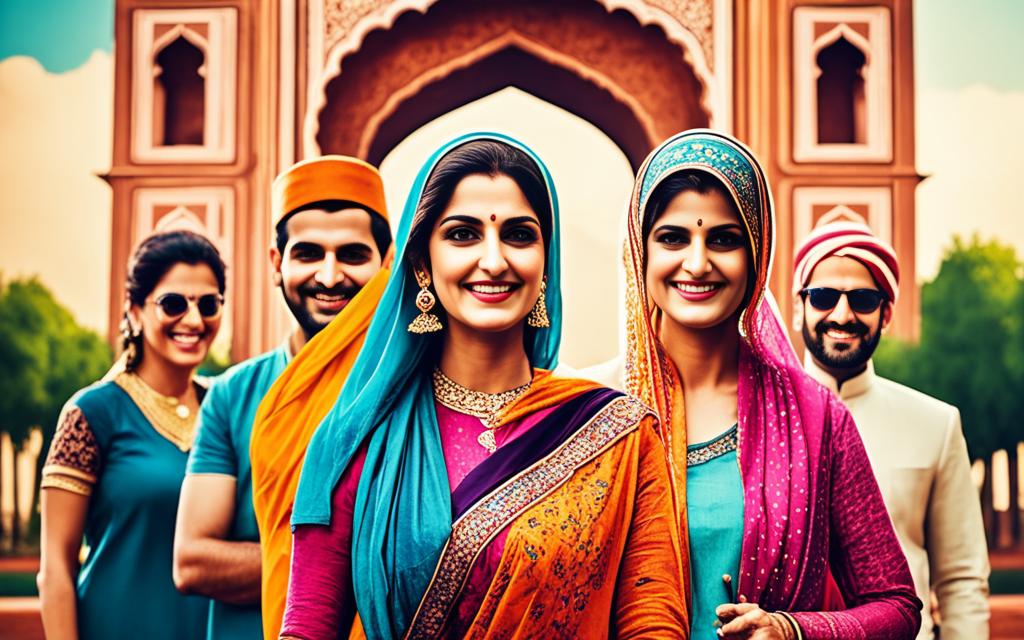
Growth Trends and Projections
From 1951 to 2011, India’s Muslim population grew to 172 million, and Hindus to 966 million. Hindu numbers increased at a rate five times faster. Muslim families are having fewer children, with rates falling sharply since the 90s. In these years, Muslim fertility dropped from 4.41 to 2.36 kids per woman. For Hindus, it went from 3.3 to 1.94 kids.1
Population Growth Rates over Decades
India has seen a slower growth in population since the 1990s. This trend is seen across all major religious groups, yet more noticeable in minorities. Between 2001 and 2011, Muslims grew by 24.7%, surpassing the 16.7% rise of Hindus and 15.7% of Christians.4 Muslims have shown a higher average annual growth rate than the total population, while Hindus’ increases are slower.4
Factors Influencing Muslim Population Growth
Government policies, including family planning and size limits, have led to lower growth rates in all religious sectors. From 1951 to 1961, Muslims held a growth rate of 2.99%, which dropped to 2.23% from 2001 to 2011. Hindus saw a peak at 2.18% from 1971 to 1981, falling to 1.55% by 2011.4 Across 1951 to 2011, Hindu growth averaged 1.95%, less than Muslims’ 2.69% and the nation’s total of 2.04%.4
Diversity within Indian Muslim Communities
The majority of India’s Muslims are Sunni. About 15% are Shia.5 Most Muslims in India are from South Asian ethnic groups. Yet, some have a bit of genetic heritage from outside, mainly from the Middle East and Central Asia.5 Still, this mix is very small. Among Muslims in India, there are different castes. This comes from the idea of Kafa’a. Ashrafs are seen as having higher status because of their Arab ancestry. But the Ajlafs are thought to be lower since they are converts from Hinduism.6 In Indian Muslim communities, marriages usually happen within the same caste.
Sectarian Composition: Sunni and Shia
Most of India’s Muslims are Sunni, but about 15% are Shia.5 These differences have a long history. They significantly influence the religious and cultural life of Indian Muslims.
Ethnic and Cultural Variations
India’s Muslim population is mostly from South Asian groups. Still, some show small signs of outside heritage, mainly from the Middle East and Central Asia.5 This mix is very minor. The idea of Kafa’a led to different castes among Indian Muslims. The Ashrafs are seen as higher due to their foreign Arab lineage. Meanwhile, the Ajlafs are seen as lower because they converted from Hinduism.6 In these communities, marrying within one’s caste is a common practice.
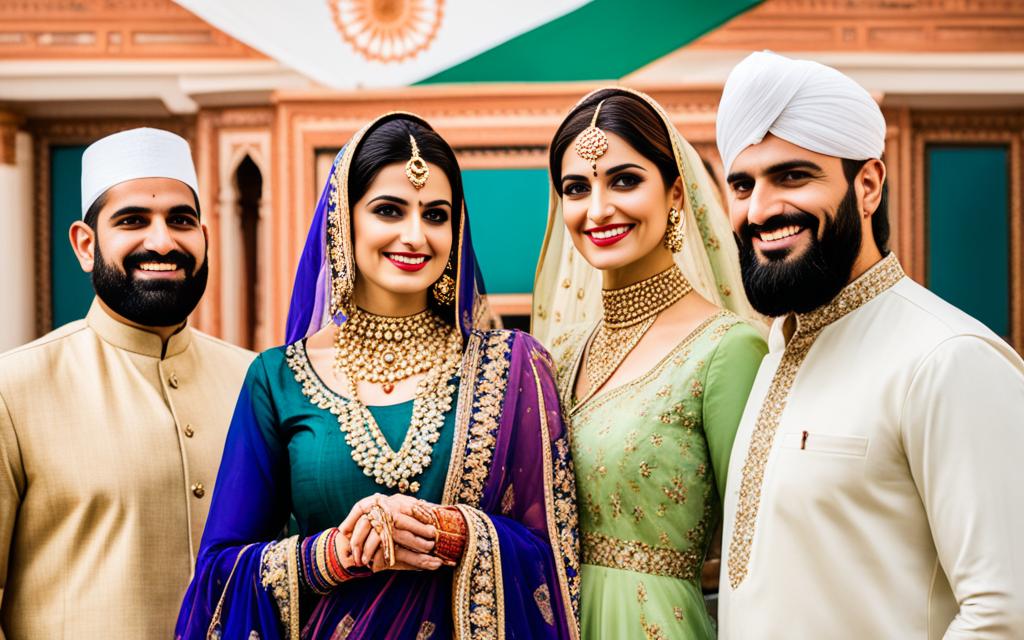
Socioeconomic Status of Indian Muslims
The National Family Health Survey says 76% of Christians come from disadvantaged castes. About 21% feel they are Scheduled Caste members. However, on the Indian census, Christians can’t mark themselves as Scheduled Caste members. This might lead to fewer Christians showing up in the census. Many Muslims, however, mainly report being part of Other Backward Classes (OBCs). This shows that Indian Muslims’ socioeconomic status is often lower than other groups. A big portion of them belong to communities or castes facing challenges.7
About 32% of India’s Muslim population is seen as “suffering” in comparison to 23% of Hindus. In India, Muslims make up almost 13% of the people. This makes them the third largest Muslim group globally, after Indonesia and Pakistan.7 The Muslim population has grown at a rate of 2.7% per year, higher than the country’s average growth of 2.1% from 1961 to 2001.7
Additionally, 31% of Muslim Indians live below the poverty line, which is higher than the country’s average of 26%. Hindus and other groups show more satisfaction with their living standards than Muslims. Muslims are more likely to find it hard to manage with their current income. Yet, more Muslim Indians have only elementary education or less, than individuals from other religious groups.7
In India, both Muslims and Hindus are generally satisfied with education. But there’s a big difference between how people in cities and villages feel. More in cities are happy than in rural areas.7
62% of Muslim Indians feel they are “struggling.” Only 6% consider themselves as “thriving.” Many feel they don’t get enough respect and worry more than the rest of the population. Still, they support women’s rights to work outside the home, just like most other Indians.7
Other sources also show the economic struggle of Indian Muslims. In 2021, over half of both Muslim and Hindu Indians found it hard to live on their current income. However, more Muslim families had trouble buying enough food. The number of Muslims who believe their living standards are falling is also higher than that among Hindus. This gap widened in 2021.8
25% of the beggars in India are Muslim. This is even though Muslims make up under 15% of India’s total population according to the 2011 census. A 2010 report found that 31% of Muslims were below the poverty line. A later 2013 survey labeled Muslims as the poorest religious group in the country.9
The evidence strongly suggests that Indian Muslims face significant economic hardships. They often live in poverty, have limited access to higher education, and face housing and amenity challenges. Addressing these problems is crucial to ensure a more equitable society for all Indians.
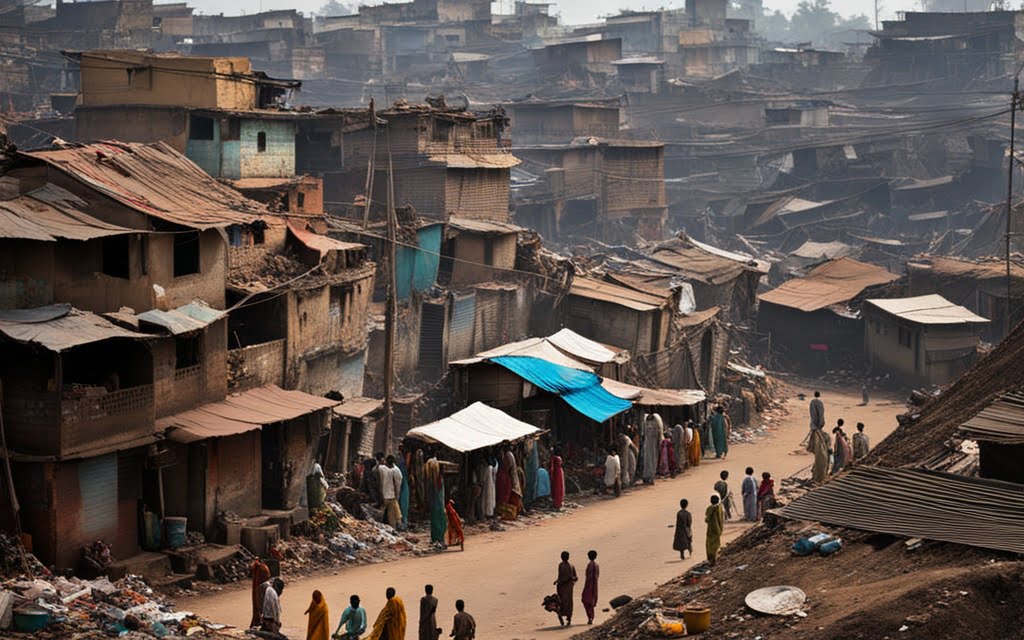
Political Representation and Influence
Indian Muslims played a big part in gaining independence, with key figures like Maulana Abul Kalam Azad and the Aligarh Movement. These groups helped a lot.10 In politics today, Muslim parties such as the AIMIM have seats in some state bodies. Yet, their sway in politics is a debated issue.10 Some argue that Muslim’s lack of access to certain benefits, like caste-based quotas, is unfair. They push for more equal chances for Muslims in politics.10
Role in India’s Independence Movement
Indian Muslims were crucial in the fight for independence. Leaders, including Maulana Abul Kalam Azad, played key roles. The Aligarh Movement by Sir Syed Ahmad Khan in the 19th century also sparked a political awakening in Muslims.10
Modern Political Landscape
Today, groups like the AIMIM hold seats in several state assemblies. But their political power is debated, with concerns over missed chances for Muslim community advancement.10 There’s a push for more political opportunities for Muslims in India.
Asaduddin Owaisi’s AIMIM has seen great support countrywide, but it’s been tough to win far from their usual spots.10 The BJP’s recent wins have also changed traditional voting alliances that included Muslims, leaving them out.10
India doesn’t permit religion to shape affirmative action. This hinders specific political representation for Muslims.10 Yet, connecting varied voting trends with the need for Muslim community political say remains a tough and changing task in India.10
| Election Year | Muslim Voting Preferences |
|---|---|
| 2020 Bihar Elections | About 77% of Muslims voted for the Mahagathbandhan.11 |
| 2021 West Bengal Elections | 75% of Muslims voted for the incumbent Trinamool Congress.11 |
| 2022 Uttar Pradesh Elections | 79% of Muslims voted for the opposition Samajwadi Party.11 |
The table shows varied Muslim voting trends in recent state polls. They strongly supported different parties in Bihar, West Bengal, and Uttar Pradesh.11 This shows the complex Muslim political scene in India. Interests and voting vary widely by region and group.11
More searches for “Pasmanda” in North India over recent years suggest growing interest in marginalized Muslim representation.11 The BJP’s choice to nominate four Pasmanda Muslims in Delhi signals a changing political field. It hints at more diverse Muslim voices being heard in Indian politics.11
Challenges and Controversies
Indian Muslims face many challenges and controversies. They are worried about being treated unfairly and not valued. Around two hundred million Muslims live in India, making up 15% of the population. This means India has a big Muslim community. Yet, they are the largest minority group as most of the people, about 80%, are Hindus.
Many global reports say India is becoming less free in terms of religion. They highlight problems faced by the Muslim community. For example, after the 2019 elections, only 5% of parliament seats were held by Muslims. This shows they have little voice in the government.
Discrimination and Marginalization Concerns
5 By mid-2022, there were no Muslims from the ruling BJP party in parliament. A report from 2019 showed that many police officers have negative views about Muslims. This can affect their help when crimes target Muslims. Also, authorities have done things like knock down Muslim homes without good reasons. They often target Muslims who have protested against such unfair treatments.
Debates around Personal Laws and Reform
5 Recently, the Modi government made a new law that some see as unfair to Muslims. This law seems to favor people from specific religions when giving out citizenship fast. The government also wants to make a big list of everyone in the country to decide who is a citizen. Many worry this could harm Muslims. They fear some might get left out because of their religion.
In the community, people argue about changing some old laws to be more fair. But, changes are hard, especially when it comes to helping Muslims in educational and jobs areas. This adds to the tension within the nation. About 32% of Muslim Indians live in tough conditions, more than people from other religions. Some politicians and groups speak badly about Muslims, making things worse.
Cultural Contributions of Indian Muslims
Indian Muslims have greatly influenced the cultural heritage of India. They are particularly notable in architecture and the arts. The Mughal architecture stands out, showcasing structures like the iconic Taj Mahal, Red Fort, and Jama Masjid.2 Muslim scholars and poets have also made their mark in Indian literature. Important figures include Amir Khusrow, Mirza Ghalib, and Allama Iqbal. They are well known for their literary and scholarly work.2 Moreover, Indian Muslim cultural practices, such as music, dance, and cuisine, have added color to the country’s culture.
Architecture and Arts
During the Mughal Empire, the Mughal architectural style flourished, showing the Muslims’ artistic and engineering skills. The Taj Mahal is a famous example. It’s a UNESCO World Heritage Site and a global architectural treasure. The Red Fort and Jama Masjid in Delhi are also significant, leaving their mark on India’s cultural scene.2 Indian Muslims have not only excelled in architecture. They have also contributed to the visual arts, music, and dance. This has added to the varied culture of India.
Literature and Scholarship
There’s a deep impact by Indian Muslim scholars and poets on literature. Amir Khusrow, Mirza Ghalib, and Allama Iqbal are well respected. They have made lasting contributions to Indian culture. Amir Khusrow, known as the “father of Urdu literature,” greatly influenced Urdu’s development.2 Ghalib is considered one of Urdu’s top poets, and Iqbal, a philosopher-poet, has deepened intellectual and spiritual thought.
The cultural traditions of Indian Muslims also uplift India’s cultural fabric.2 Qawwali’s soulful music and Kathak’s graceful dance are significant contributions. The varied and rich cuisine, with its special spices and cooking methods, is integral to India’s food culture.
Interfaith Harmony and Integration
India faces challenges in bringing different faiths together. Yet, efforts to blend the Muslim community into Indian society continue. Programs promote living in peace, including talks and local groups. These projects aim to build understanding between Muslims and Hindus. They push for unity and acceptance, despite ongoing issues. This work is slowly strengthening India’s mix of religions.2
Efforts towards Religious Coexistence
India is known for its mix of religions, mainly Hinduism and Islam. This tradition goes way back. For centuries, people have tried to understand and help each other live in peace. One key early step was when Arab Muslims settled in India in the 7th century CE. Their culture merged with India’s, leading to today’s diverse and peaceful blend of faiths.2
Role of Education and Awareness
Teaching people about each other is vital for peace between Hindus and Muslims in India. These lessons include sharing traditions and history, helping people understand each other better. They’re making a difference in how we see each other. By learning more about the Indian Muslim community’s many layers, from its culture to its past, people are fighting false impressions. They are celebrating how the Muslim community enriches India’s cultural life.2
Conclusion
India’s Muslim population makes up around 14.2% of the nation. Its history is both rich and complex. It began with Islam’s early arrival on the coast. Then, Islam spread through conquests and settlements in India.1
This community has seen its fair share of challenges. They include worries about being treated unfairly and left out. In spite of this, Indian Muslims have greatly enriched their country. They helped shape India’s culture, architecture, and literature.1
The Indian Muslim community is broad and varied. It covers different religious groups and has a mix of many cultures. This shows just how diverse India’s religious scene is.1
In India, the debate over religious harmony is ongoing. The country is working hard towards being more inclusive. Steps like creating fair policies and spreading knowledge are key. They help people of all faiths understand and live together peacefully.1
The conclusion on muslim population in india is clear. We need to keep building a society where everyone feels welcome. This means highlighting and valuing the contributions of every citizen, no matter their faith.1312
FAQ
What is the total Muslim population in India?
In 2011, India was home to the world’s third-largest Muslim population. Muslims made up about 14.2% of the country’s people. This percentage added up to around 172.2 million individuals.
How is the Muslim population distributed across different regions in India?
The states with the most Muslims include Uttar Pradesh, West Bengal, Bihar, and Maharashtra. Jammu and Kashmir stands out as a state where most people follow Islam. Lakshadweep, a group of islands, is mainly Muslim as well.
What is the growth trend of the Muslim population in India?
From 1951 to 2011, the number of Muslims grew from 35.4 million to 172 million. Meanwhile, Hindus grew from 303 million to 966 million. Even though the Hindu population spike was higher, Muslim fertility rates are dropping quickly. Their fertility dropped from 4.41 to 2.36 kids between 1992 and 2021.
What is the sectarian composition of the Muslim population in India?
The Sunni denomination is the largest among Indian Muslims. About 15% are Shia. Most Indian Muslims are from South Asia. Yet, some show signs of ancestry from the Middle East and Central Asia.
What is the socioeconomic status of the Muslim community in India?
Over half of Indian Muslims are seen as part of the Other Backward Classes (OBCs). This points to their relatively lower standing compared to other groups. Many also come from disadvantaged castes and communities.
What has been the role of the Muslim community in India’s independence movement and modern political landscape?
Indian Muslims played a big part in gaining independence. Figures like Maulana Abul Kalam Azad were key. In today’s politics, groups like the All India Majlis-e-Ittehadul Muslimeen (AIMIM) have some power. Still, the extent of their influence is often debated.
What are the key challenges and controversies faced by the Muslim community in India?
There are many challenges and controversies. These include worries over discrimination and being left out. The debate over personal laws and calls for reform are ongoing. The Hindu-majority often sees Muslims as a threat, causing tension and debates.
How have Indian Muslims contributed to the country’s cultural heritage?
Indian Muslims added a lot to India’s culture, especially in architecture and art. The Taj Mahal, Red Fort, and Jama Masjid highlight Muslim architectural skills. Muslim poets and scholars made key contributions to India’s literature. Their rich cultural traditions also enhance India’s diverse culture.
What efforts are being made to promote interfaith harmony and the integration of the Muslim community in India?
India is making efforts to enhance interfaith relations and blend the Muslim community in. This includes programs for cooperation and dialogue. Emphasizing education and awareness is crucial for understanding between Hindus and Muslims.
Source Links
- https://www.pewresearch.org/religion/2021/09/21/population-growth-and-religious-composition/
- https://en.wikipedia.org/wiki/Islam_in_India
- https://www.aljazeera.com/news/2024/5/18/has-indias-muslim-population-really-exploded
- https://educationforallinindia.com/size-of-muslim-population-in-india/
- https://www.cfr.org/backgrounder/india-muslims-marginalized-population-bjp-modi
- https://www.pewresearch.org/religion/2021/06/29/religion-in-india-tolerance-and-segregation/
- https://news.gallup.com/poll/157079/muslims-india-confident-democracy-despite-economic-educational-challenges.aspx
- https://news.gallup.com/poll/396887/economic-pain-uneven-india-muslim-hindu-populations.aspx
- https://www.theswaddle.com/why-the-economic-marginalization-of-indian-muslims-is-systemic
- https://casi.sas.upenn.edu/iit/hilalahmed
- https://carnegieendowment.org/2024/02/09/mapping-muslim-voting-behavior-in-india-pub-91579
- https://www.pewresearch.org/short-reads/2021/09/21/key-findings-about-the-religious-composition-of-india/

